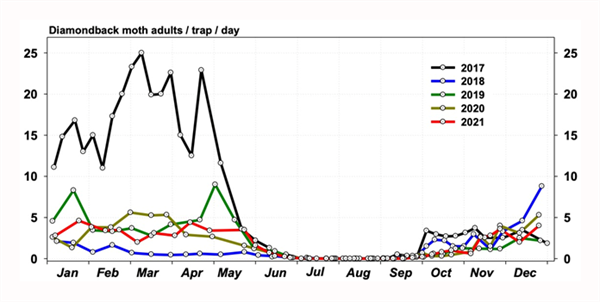It looks like we dodged a bullet from Hurricane Hilary; about ½ inch of rain and 50 mph wind gusts on Sunday. But time will tell if she delivered any unwelcomed guests. Insects are notorious for hitching a ride on the winds associated with the remnants of hurricanes and tropical storms originating off the coast of Baja Mexico. As the storms dissipate upon arriving in the desert, they tend to “release” the flying pests onto our fall crops. The Diamondback Moth (DBM) is a good example. Following the DBM outbreaks during the 2016-2017 season, we established over 50 pheromone traps from Texas Hill to San Luis to monitor year-round DBM activity over a three-year period. The most important thing we learned from that study was that trap catches during the summer months in all three years showed that DBM were non-existent in the desert during July and August due to the unavailability of suitable brassica host plants. In essence, the populations become “extinct” during this two-month window when Cole crops and brassica weeds are absent. Thus, DBM disappear in the summer, only to reappear in the fall on transplanted and direct-seeded cauliflower, cabbage and broccoli. Of course, we know from firsthand experience that DBM will come into the desert from transplants produced in CA coastal growing areas where DBM are active year-round. However, we also observed that sharp increases in areawide moth trap captures in October occurred following the remnants of Hurricane Rosa (Sep 30), and in again 2019 following remnants of Hurricane Lorena (Sept 24). Shortly thereafter, PCAs began reporting DBM larvae appearing on seedling stands and newly transplanted crops throughout Yuma. This strongly supports our contention that these DBM populations migrated into the area on these storms. In contrast, in the fall of 2020, monsoon activity was negligible in Yuma and no tropical storms/hurricanes were reported in the region. Accordingly, we only observed significant DBM activity adult in traps adjacent to transplanted cauliflower and cabbage fields in mid-September further suggesting that transplants certainly play an important role in annual reinfestation of fall Cole crops in the absence of wind events. But DBM is not the only insect pest that migrates into the desert from storms.
Other lepidopterous pests are known to migrate from Mexico. Remember the cabbage budworm, that unusual pest that showed up in the desert in late September infesting the terminals and stems of transplanted cauliflower and direct-seeded broccoli. It is a rare pest and had never been reported on desert crops before. Because the cabbage budworm is of tropical origin, it was likely no coincidence that budworm larvae began to appear in the desert following heavy monsoon storms and the remnants of hurricane Kay in early September. The high humidity in the desert last fall season likely made the pest feel right at home.
Bottom line: DBM are like a box of chocolates: “You never know what you’re going to get”. Do not become complacent. Because DBM populations disappear from the desert each summer and reappear on fall crops from outside sources (see graph below), we never really know where they originate from, when they will show up, how abundant fall populations will be, or how susceptible to insecticides they are. So be vigilant in scouting and follow IPM guidelines for DBM management. For more information see:
- Impact of Diamondback Moth on Desert Cole Crops, 2016-2021
- Cabbage Budworm in Desert Cole Crops
- 2023 Guidelines for Diamondback Moth Management in Desert Cole Crops






